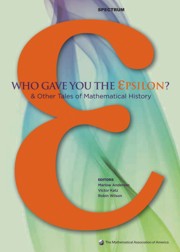Book contents
- Frontmatter
- Introduction
- Contents
- Analysis
- Foreword
- Who Gave You the Epsilon? Cauchy and the Origins of Rigorous Calculus
- Evolution of the Function Concept: A Brief Survey
- S. Kovalevsky: A Mathematical Lesson
- Highlights in the History of Spectral Theory
- Alan Turing and the Central Limit Theorem
- Why did George Green Write his Essay of 1828 on Electricity and Magnetism?
- Connectivity and Smoke-Rings: Green's Second Identity in its First Fifty Years
- The History of Stokes' Theorem
- The Mathematical Collaboration of M. L. Cartwright and J. E. Littlewood
- Dr. David Harold Blackwell, African American Pioneer
- Afterword
- Geometry, Topology and Foundations
- Algebra and Number Theory
- Surveys
- Index
- About the Editors
Evolution of the Function Concept: A Brief Survey
from Analysis
- Frontmatter
- Introduction
- Contents
- Analysis
- Foreword
- Who Gave You the Epsilon? Cauchy and the Origins of Rigorous Calculus
- Evolution of the Function Concept: A Brief Survey
- S. Kovalevsky: A Mathematical Lesson
- Highlights in the History of Spectral Theory
- Alan Turing and the Central Limit Theorem
- Why did George Green Write his Essay of 1828 on Electricity and Magnetism?
- Connectivity and Smoke-Rings: Green's Second Identity in its First Fifty Years
- The History of Stokes' Theorem
- The Mathematical Collaboration of M. L. Cartwright and J. E. Littlewood
- Dr. David Harold Blackwell, African American Pioneer
- Afterword
- Geometry, Topology and Foundations
- Algebra and Number Theory
- Surveys
- Index
- About the Editors
Summary
Introduction
The evolution of the concept of function goes back 4000 years; 3700 of these consist of anticipations. The idea evolved for close to 300 years in intimate connection with problems in calculus and analysis. (A one-sentence definition of analysis as the study of properties of various classes of functions would not be far off the mark.) In fact, the concept of function is one of the distinguishing features of ‘modern’ as against ‘classical’ mathematics. W. L. Schaaf ([24], p. 500) goes a step further:
The keynote of Western culture is the function concept, a notion not even remotely hinted at by any earlier culture. And the function concept is anything but an extension or elaboration of previous number concepts—it is rather a complete emancipation from such notions.
The evolution of the function concept can be seen as a tug-of-war between two elements, twomental images: the geometric (expressed in the form of a curve) and the algebraic (expressed as a formula—first finite and later allowing infinitely many terms, the so-called analytic expression). (See [7], p. 256.) Subsequently, a third element enters, namely, the logical definition of function as a correspondence (with a mental image of an input-output machine). In the wake of this development, the geometric conception of function is gradually abandoned. A new tug-of-war soon ensues (and is, in one form or another, still with us today) between this novel logical (abstract, synthetic, postulational)conception of function and the old algebraic (concrete, analytic, constructive) conception.
- Type
- Chapter
- Information
- Who Gave You the Epsilon?And Other Tales of Mathematical History, pp. 14 - 26Publisher: Mathematical Association of AmericaPrint publication year: 2009
- 1
- Cited by

